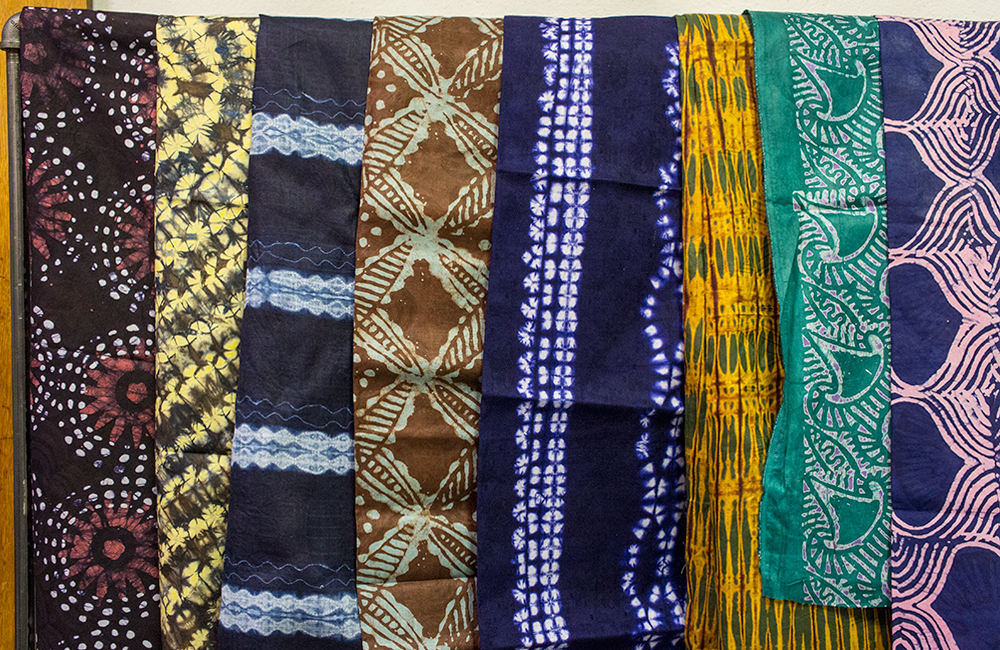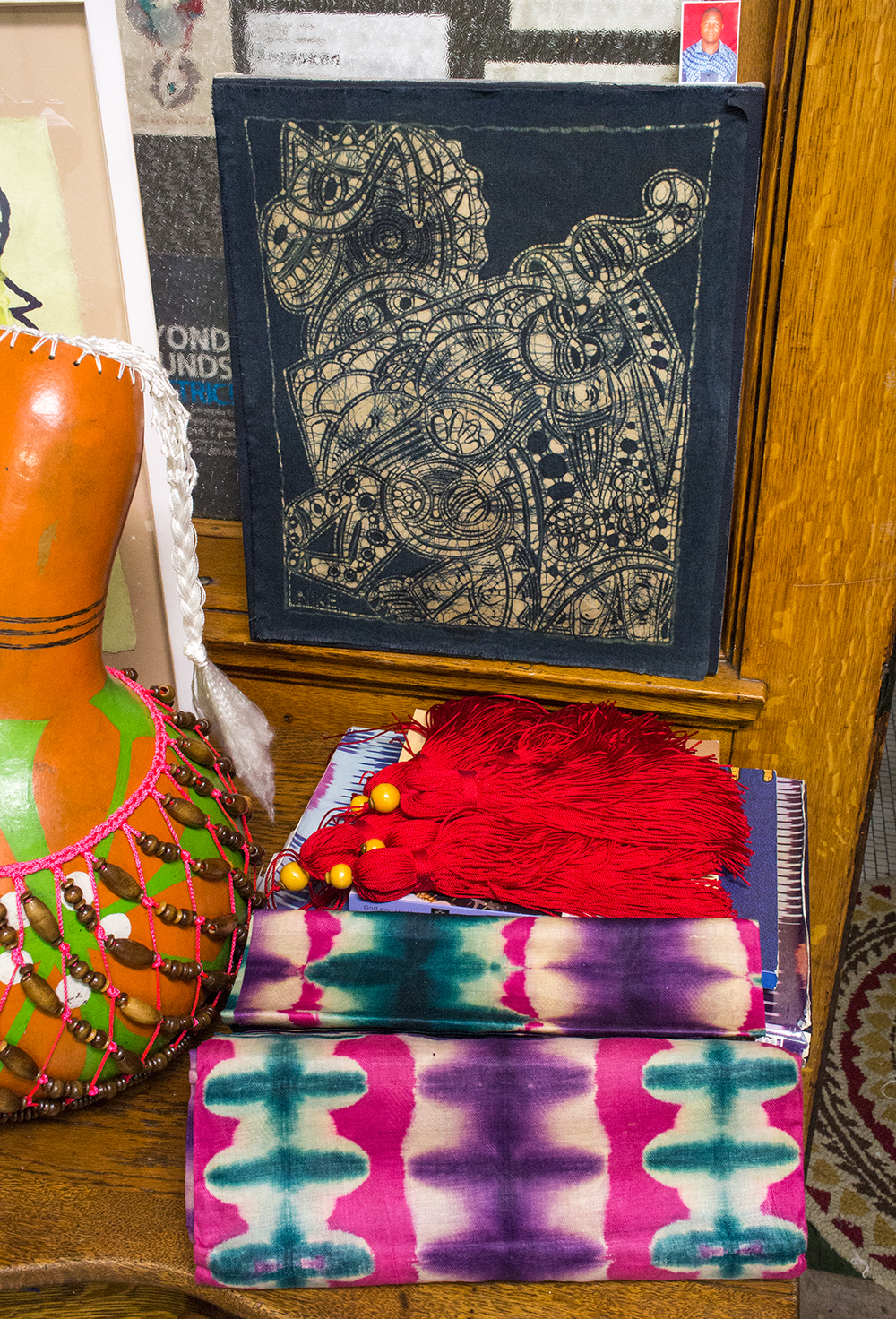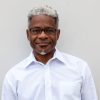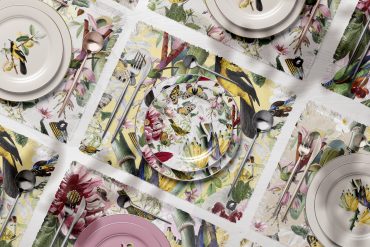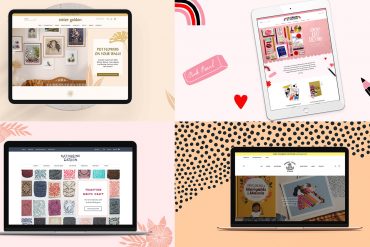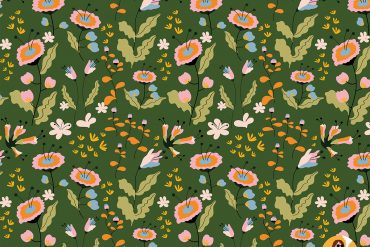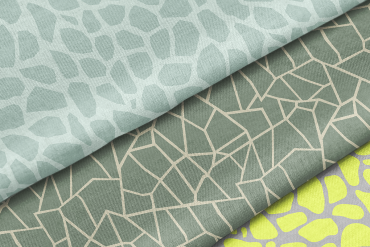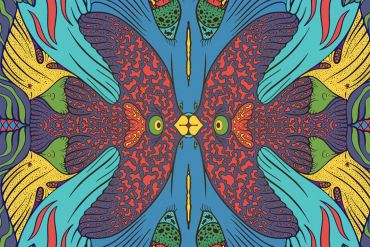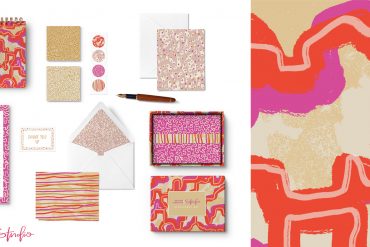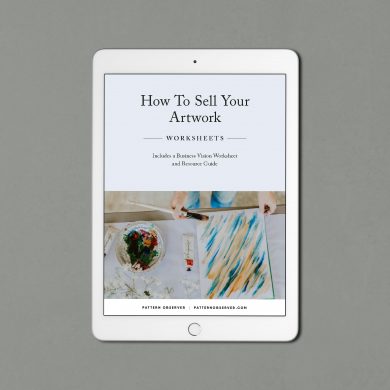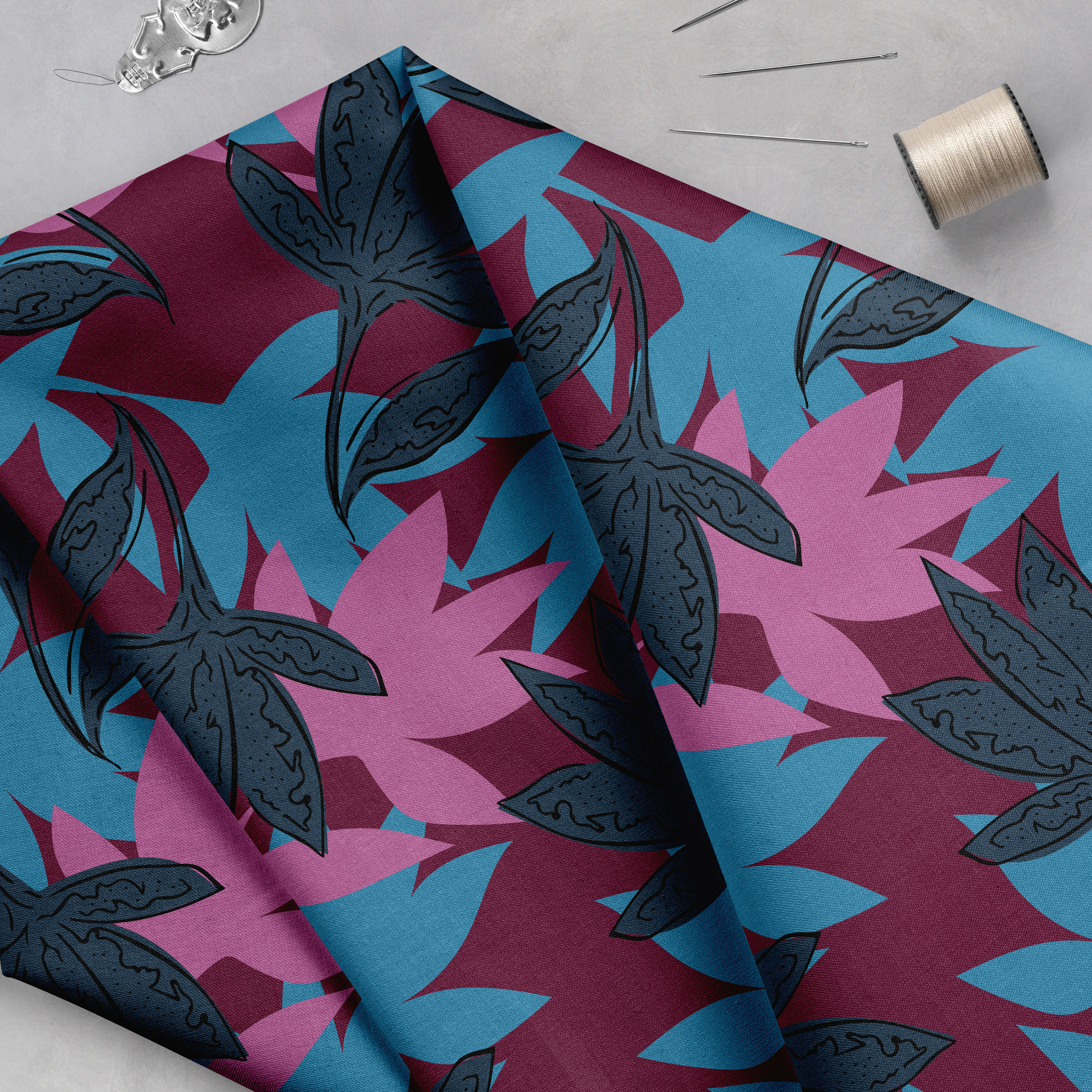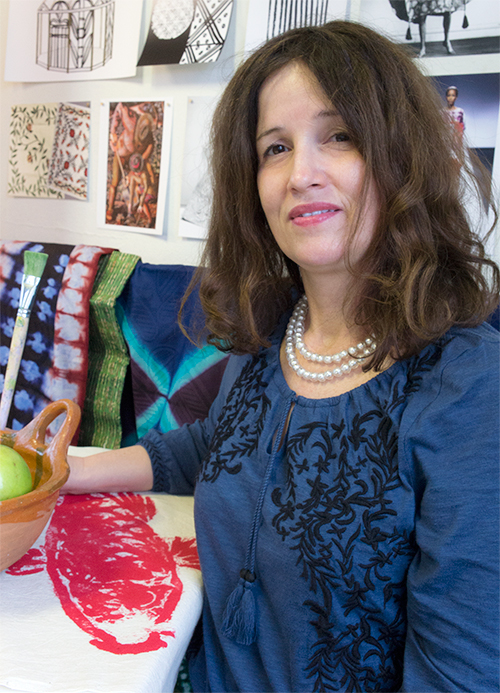
Later this month Maria will be sharing a tutorial with Textile Design Lab students, on techniques she learned during her time spent in Nigeria. Keep an eye out for an excerpt here on the blog, and in the meantime please enjoy our interview with Maria below!
Please tell us a bit about your design background/career path. How did you become interested in textile design?
Hi everyone. I first came to Kansas City to study art on scholarships from the high school I attended and the art school here. Ken Ferguson, a ceramics professor, attracted me to the Art Institute – I still see him as the most outstanding artist to have ever worked in Kansas City. I majored in ceramics, spent a semester in France working in carved stone/sculpture, and then finished my BFA in painting. I went on to do an MFA at Yale School of Art where I studied painting and printmaking, with electives in figure sculpture. Later on, I spent three summers working in the silkscreen studio at School of Visual Arts in New York. In school some bodies of my work included painted drapery, and eventually I chose to make drapery or clothing the sole subject/theme with my paintings.
Later my work shifted from painting cloth or clothes to photographing assemblages constructed from fabrics. At this juncture I asked myself, “where is the painting in this work ?” and I proceeded to color and pattern fabrics for my projects with printed and dyed imagery. In my current practice, I work across an array of media and my experience with drawing, color, printmaking, and 3D processes all factors in.
Could you tell us a bit about your residencies and research trips abroad? How have your travels impacted the work you do today?
One summer I did a formal artist’s residency on the southern coast of Spain, but my other foreign residencies and projects were all self-styled. Most recently I have focused on Nigeria. There I worked with artists in Oshogbo and rural Kogi State, and then in a dyeing district in Lagos and also at Abeokuta. The fact that there are few travelers in Nigeria means that ways of life there are less westernized, it’s a place set apart. Nigerians you haven’t met often say “you are welcome” when passing on the street, and in Yorubaland children and adults alike would cry out “Oyinbo !” (white person) to me in greeting. Some of the challenges with traveling there are frequent power outages and the cash economy: you can’t use credit cards or travelers checks.
In Nigerian culture, textiles are particularly important. You usually work with a tailor when you need something new to wear, and you bring the fabric… perhaps it’s hand-dyed fabric from Abeokuta or maybe cloth you commissioned from a dyer in Lagos.
Each place where I studied dyeing was quite different from the others. At the workshop in Oshogbo students work mainly in hand drawn batik, in Kogi State matrons run a paste resist workshop, in Akerele/Lagos students work alongside Nigerian and Gambian men whose livelihood is dyeing cloth and the emphasis is on printed batik and tie & dye.
In Abeokuta, every last person seems to be involved in dyeing, from grandmothers to the children when they’re home from school. The economy’s built around hand-dyed cloth and expediency is required to succeed. Variations on alale – a style of tie and dye done with fine hand pleating – are popular. Paste resist is combed in waves over five yard lengths laid on tables, section by section. Elders work at treadle machines sewing systems of folds into yardage, seams that will be pulled apart after dyeing to reveal intricate resist patterns. I was astonished to see fabric paint in Abeokuta and ultimately came to appreciate how it could be quite beautiful when applied sparsely over dyed designs (flecks of bright white compare to tiny rhinestones on “African” lace Nigerians import from Austria, etc.).
While some American textile artists and fashion designers do work with hand dyed cloth, the practice of hand dyeing isn’t integral to our culture and economy in the same way. Vivid clothes worn on the street (by the likes of mothers with babies tied to their backs or men toting sewing machines on their heads, hands-free) are characteristic of the Nigerian way of life.
To get along in Africa, people need to be resourceful. You see artists fashioning tools from scrap materials, systems put in place, and people working at a fast pace – a busy dyeing yard is called a “factory.” Something that drew me to Nigeria is the way that fabric produced there is painterly and sometimes even pictorial. Time spent in Nigeria has given me a view of how textiles can be paramount, a catalog of ways for working with textiles in a painterly sense, and models for working efficiently and economically.
Dyeing techniques used in Nigeria are all resist in one form or another. At first I didn’t imagine working in batik yet I mastered it and have devised adaptations for working with batik in my indoor studio here.
Tell us a bit about your design process. What media/design tools do you like to use?
Hot wax for batik is rather hard to manage, yet foam rubber makes a great applicator. You can cut foam into a stylus or a printing block with scissors, and I’ve also been cutting foam and wood with a laser cutter. I heat wax in an electric skillet and lay the fabric to be patterned on a large waxed board. You need to lift the fabric regularly so it won’t stick to the board – prying it off will leave the cloth bare on back (which may affect coloration). For me this system works better than stretching the cloth and applying wax with a tjanting tool. It did take a lot of practice to gain facility, and I could probably become adept with the Indonesian method if I spent time with it. We know no one learns Photoshop overnight, and so it is with many design processes. I tell students to be like the puppy with a new toy – shake the living daylights out of it, don’t let go.
Where do you gather inspiration for your work? Are there any books, blogs, magazines, etc. that you recommend?
For me, one thing leads to another. When you spend a lot of time with your work your mind naturally makes connections. Curiosity leads me to research – this may involve web searches, visits to libraries, making inquiries, and/or visits to museums or other relevant sites.
News can be pertinent to shaping new projects and identifying opportunities, too: I listen to the BBC World Service and the local NPR station for stories on culture & current events and interviews with authors. Through Facebook I find interesting reading material that’s shared by friends; Duncan Clarke is an authority on African textiles who maintains a web presence and participates in social media, by the way. When in waiting areas, I page through popular magazines (including local ones) looking for striking images and news of arts and culture in society.
At this point, my personal library has been whittled down; if there’s a book I’d like to read I get it from the public library – if they don’t have it, I ask them to order it. I enjoyed reading New African Fashion by Jennings and Prince Twins Seven-Seven… by Glassie.
Who are your design heroes (past or present)? What about them inspires you or influences your work?
I’m choosey about what I embrace and extol – so if I say this artist or that, I do have certain works in mind. Imaginative paintings by Sir Stanley Spencer that emphasize pattern on clothing (worn by characters) are exciting to me, and I also look to some of Niki de St. Phalle’s work for the way pattern and color cooperate with abstracted human form. Last year when inputting terms of interest into a web search, I happened upon Caterina Bortolussi. An Italian running the Kinabuti fashion label from Nigeria, Caterina seeks to make fashion a viable industry for the country and to afford Nigerian women with livelihoods; Kinabuti’s fall 2015 Rome collection focused on hand-dyed fabrics. A couple years ago I reached out to Joyce Kozloff of art history Pattern and Decoration era fame, and she introduced me to her friend Robert Kushner; Kushner’s work from the 1970’s (including wearable paintings) has become an inspiration with my current projects.
Over the course of your career, what actions or decisions have made the biggest impact on your design business?
Association with passionate people is a key. In our youths we were all students, and we discovered that some teachers are particularly passionate. During my education and in similar situations since, I’ve searched for the right combination of instructor, subject, and school or circumstance. Decisions weren’t easy, sometimes I left a class. Looking back, I can see that the choices were astute. Identifying with passionate people puts you in that group. By tendency, I gravitate toward foreigners and people with foreign connections; this and experience abroad affect my view of the world and the society in which I live. Location is important. In 2006 I returned to Kansas City, and in 2009 I chose my current studio: both are favorable environments for artists. I’ve been working with Photoshop and digital photography for more than a dozen years, and through taking a class here and a workshop there I’ve polished my writing skills – Photoshop, photography, and writing are important tools with moving my practice forward.
What have been some of the challenges you have faced throughout your design career and how have you overcome them?
Well, there have been challenges from without and challenges of my own making. Generally, each new project seems to be the greatest challenge I’ve taken on. Something that we all contend with is acceptance of our creative work, usually through sales or funding. The best ways to keep things in balance are to believe in your work, apply creativity toward keeping costs down, and put your own brand of charisma to use in all that you do. Last year I was commissioned to create a couple of billboards that were displayed in Kansas City’s Crossroads arts district for three months. I was interested in having a wide audience for the work, and I wanted people to be apprised of the theme (an amusing bit of ancient art history). I contacted every news organization I could think of and followed up on replies, yet two weeks into the display I couldn’t see a way forward with the news. I decided to print a postcard using an online service, did 3 test batches simultaneously, and printed a large run for under 5 cents per card. I then used the card as a talking point with people I knew or chanced to meet at networking events, left stacks at art galleries and coffee shops, and sent cards to news writers and interviewers. This worked out well, and an illustrated interview about the project was published in the Sunday edition of the Kansas City Star. I’m still hearing from people who tell me they went to see the work because they read about it in the paper !
What would you consider to be your greatest success so far?
I can’t really confirm this, but along the way someone told me that when asked which was his greatest painting, Matisse would reply “the one on the easel now.” Projects slated for 2016 will be quite amazing, but there’s much to do. So let me roll up my sleeves, and please check back.
What advice have you received in your career that has stayed with you or influenced you? Do you have any words of wisdom for aspiring designers trying to build successful careers of their own?
You can have it all, but not right away.
Victor Babu (to me)
It will take both wisdom and patience to get an elephant into the city.
Yoruba proverb
Every great and original writer must himself create the taste by which he is to be relished.
William Wordsworth
How wonderful it is that nobody need wait a single moment before starting to improve the world.
Anne Frank
A thimbleful of red is redder than a bucketful.
Henri Matisse
I’ve learned that people will forget what you said, people will forget what you did, but people will never forget how you made them feel.
Maya Angelou
Become a Textile Design Lab member to gain access to Maria’s tutorial when it becomes available later this month, in addition to all of our past guest expert tutorials and the other helpful e-courses and features of the Lab. Visit textiledesignlab.com to learn more!


